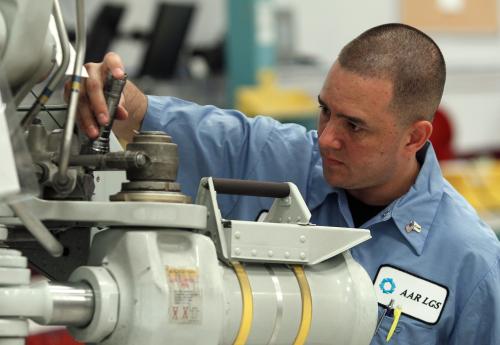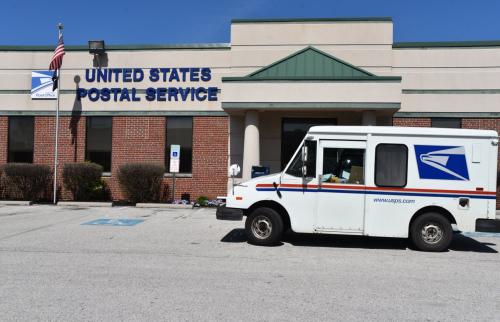The following brief is part of Brookings Big Ideas For America—an institution-wide initiative in which Brookings scholars have identified the biggest issues facing the country and provide ideas for how to address them. (Updated February 3, 2017)
Executive Summary
 Infrastructure is a highly stratified policy sector within Washington and between federal, state, and local actors. Any new multibillion-dollar federal infrastructure effort will require major congressional action to approve additional borrowing or business tax reform, accompanied by major programmatic reforms to overcome existing institutional silos and promote state and metropolitan innovations.
Infrastructure is a highly stratified policy sector within Washington and between federal, state, and local actors. Any new multibillion-dollar federal infrastructure effort will require major congressional action to approve additional borrowing or business tax reform, accompanied by major programmatic reforms to overcome existing institutional silos and promote state and metropolitan innovations.
With Washington’s recent record of partisan gridlock, federal leaders must separate what can be accomplished in short order from what will require a more sustained conversation with political allies and adversaries. Meanwhile, even with a public hungry for improved infrastructure performance, experts and many budget-conscious voters want to ensure any new investments have a high return on investment. The country must modernize, but it must be sensible in its approach. Rushing to get an infrastructure stimulus package out in the first 100 days of the new administration, for instance, could lead to inefficient project selection criteria.
Before focusing on how much to invest, federal leaders must first recognize where to invest for best results. Focusing too much on aggregate dollar figures not only overlooks the range of infrastructure needs across the country, but also fails to consider the specific economic criteria and performance measures necessary to determine more precise returns on investment. The heightened focus on dollar amounts also discounts infrastructure’s full impacts in the labor market. While policymakers often trot out the same tired figures—with every $1 billion in federal spending supporting up to 13,000 jobs each year—infrastructure’s greatest returns in the labor market are good-paying jobs, with minimal barriers to entry, and that last long after construction ends.
Background
Calls for increased infrastructure investment have been echoed for years now, and this election season is no different. As the U.S. economy continues to make strides following the Great Recession, infrastructure remains one of the more attractive areas to improve productivity and create jobs. Of course, finding reliable ways to pay for such improvements and investing more wisely remain central to delivering on those economy-enhancing objectives.
Infrastructure, however, continues to stand out as one of the few policy areas where the candidates find common ground.
Fortunately, now is a great time to boost public investment. With historically low interest rates and the potential for infrastructure projects to deliver long-run economic returns, economic writers such as Paul Krugman, Lawrence Summers, and Tyler Cowen all believe infrastructure investment could address the country’s sluggish aggregate growth rates. Nevertheless, simply building more will not guarantee economic growth on its own, as infrastructure booms in Japan, China, and other countries reveal. This lesson is particularly important considering the falling returns from public investment in U.S. highways.
There is demonstrated need across the country to justify higher investment rates. Many roads, bridges, and other systems are reaching the end of their useful life. As the U.S. population grows, as climate pressures intensify, and as concerns rise over health and safety, pipes, sea walls, and treatment facilities are buckling under pressure. Yet total public spending on infrastructure—at $416 billion annually—is on the decline according to most measures. As a share of gross domestic product (GDP), infrastructure spending now stands at around 2.5 percent—down from a high of 3 percent in 1959—and federal purchases have fallen by nearly 19 percent in real terms since 2003. Meanwhile, states and localities have picked up the slack, but they, too, can struggle to keep up with mounting maintenance and capital expenses.
Yet unlike past election years, infrastructure is a central platform in both the Democratic and Republican campaigns. There is real promise that November is the first step in addressing these infrastructure deficiencies.
Hillary Clinton’s infrastructure plan seeks to “build tomorrow’s economy today” through a five-year, $275 billion effort, primarily supported by business tax reform. In particular, $250 billion would be direct public investment, while another $25 billion would create a new national infrastructure bank that would help finance a wide range of transportation, freight, water, and telecommunications projects with additional private-sector involvement. The reauthorization of a Build America Bonds (BABs) program would complement these efforts. Clinton’s plan lays out a number of overarching goals and policy details, including creating good-paying jobs, reducing congestion, expanding transit options, and achieving universal Internet access.
Donald Trump’s plan is even more ambitious, aiming to at least double Clinton’s total proposed infrastructure spending at $500 billion or more. While still light on many details, Trump’s plan would issue a series of new “infrastructure bonds” and establish a new “infrastructure fund” to pool a wide assortment of public and private financial resources. Ultimately, the plan aims to drive next-generation infrastructure improvements focused on increased transportation connectivity, more efficient operational performance, and a greater reliance on American industries and workers to power future upgrades.
These platforms are a great start, but the real work will begin once a new president is in office and congressional leaders are in place. At that point, reforming the federal infrastructure program will require a recognition of the major challenges facing this critical policy area.
First, the country’s greatest infrastructure needs are in metro areas, yet federal infrastructure investment too often runs through states. America’s 100 largest metropolitan areas are the hubs of the U.S. economy. They house two-thirds of the country’s population, generate three-quarters of its GDP, and do so on only about one-tenth of the country’s land mass. The spatial design and industrial composition of each metro area vary considerably. The variety requires different solutions to maximize each place’s economic potential. From Portland to Milwaukee to Miami, local leaders know this quite well as they customize new plans, develop new metrics, and spearhead new investments, including the use of ballot measures and public-private partnerships. Many of these areas are also creating more collaborative, comprehensive strategies to boost resilience, improve transportation access, and address skill gaps in their workforce. Federal infrastructure policy must support a new federalism that recognizes metropolitan primacy and supports metropolitan innovation.
Second, the federal government’s approach to infrastructure planning and investment remains highly fragmented and with little formal requirements to test for economic returns. Metropolitan infrastructure systems consist of multiple, interwoven components—from highways and waterways to telecommunications and energy distribution—that vary widely in their design, construction, operation, and financing. Yet different federal agencies and congressional committees claim some oversight of these different components. As a result, policymakers and planners may evaluate projects differently, rely on inconsistent performance measures, and fail to account for costs and benefits efficiently.
For example, the U.S. Department of Transportation (DOT) does not always coordinate with the U.S. Department of Commerce when setting economic priorities for freight movement. Multiple divisions within DOT operate in siloes and use scarce budget resources ineffectively. This haphazard organizational structure presents challenges to identifying reliable, stable sources of funding, particularly as the federal gas tax generates less revenue for future projects.
In the face of these challenges, the past eight years have proved that Washington can still advance infrastructure ideas, but many efforts have failed to move the dial enough. The period began with the American Recovery and Reinvestment Act of 2009 (ARRA), an enormous public works program that at times had questionable project selection criteria. In December 2015, Congress approved the first long-term transportation bill in nearly decade, dubbed Fixing America’s Surface Transportation (FAST) Act, which provides more certainty for local spending but also falls short in advancing multimodal planning efforts and developing durable sources of funding. Other federal efforts—including DOT’s Ladders of Opportunity initiative, the Environmental Protection Agency’s Clean Water rule, and the Federal Communications Commission’s expanded Lifeline program—have helped improve economic opportunity, environmental sustainability, and digital connectivity, but more work remains.
Policy Recommendations
The next administration and Congress should adopt a two-pronged infrastructure strategy to (1) advance immediate proposals that build on existing reform efforts, and (2) begin to develop new platforms for long-term policy change. Irrespective of which candidate wins or how congressional leadership may change, federal leaders are at a crucial inflection point to advance reforms across a variety of infrastructure sectors and geographic scales. Those reforms should be governed by a new federal strategy that draws inspiration from ongoing state and local efforts, where many innovative infrastructure plans and best practices continue to emerge.
This brief touches on four major infrastructure priorities in this respect: transportation, water, broadband, and infrastructure workforce development. Although they do not cover all infrastructure sectors, these four priority areas demonstrate the need for additional federal investment, financial flexibility, and programmatic direction. Again, rather than focusing on how much infrastructure investment should occur—in total or within each sector—this brief aims to inform a more extensive conversation on funding and financing once the new administration and Congress take office.
Transportation
In the short term, federal legislators and DOT should design competitive and financially innovative programs, and then Congress should appropriate enough funding to execute them.
- Congress should increase appropriations for the Transportation Investment Generating Economic Recovery (TIGER) grant program, which pumped billions of dollars into a range of multimodal projects nationally, but additional funding should require reformed accountability measures.
- Reinstating the Build America Bonds program and exempting private activity bonds from the alternative minimum tax could leverage low interest rates and tax advantages to promote investment in economically critical infrastructure projects.
- Congress must recognize the aviation network’s hub-and-spoke system is here to stay. Whether within broader legislation or a stand-alone vehicle, policymakers should raise the current cap on Passenger Facility Charges and adjust formulas under the Airport Improvement Program to facilitate movement of passengers within the U.S. aviation network.
- Finally, intense interest for the Smart Cities Challenge should motivate Congress to consider developing a funding pool for similar future-looking competitive programs.
Likewise, executive branch agencies should continue to use the rulemaking process where possible to modernize regulations under current authorizing legislation. Performance measures are a vital area in this regard, as evidenced by ongoing debates around whether congestion and greenhouse gas emissions are appropriate measures of highway performance, or whether consolidating the country’s dizzying number of Metropolitan Planning Organizations would lead to a more efficient planning process. Each of these proposed rules may not get settled until the next administration, and the incoming administration should respond to public comments and continue to refine these proposals. The next four years are also ripe with potential for automated vehicle (AV) guidance, creating an opportunity for DOT to better understand the kinds of flexible safety and urban planning standards that can allow the market to grow while preparing policy responses for potential market failures.
The highway expansion era is over, but what is next?
In the long term, the federal government must determine its 21st century priorities and develop dedicated revenue sources to pay for multimodal transportation needs.
Coming surface transportation and aviation reauthorizations are enormous opportunities to execute such reforms. Without greater financial certainty, the Highway Trust Fund—the primary vehicle for federal and state transportation investment—will continue to teeter on the edge of insolvency, and many regions will delay needed projects. Ongoing experimentation with new user fees, expanded loan programs, and adjusting federal formulas—including a “fix it first approach,” prioritized freight investments, and a reformed TIFIA program—should be part of the next multiyear surface transportation bill.
Yet hanging over the surface transportation program is a debate over priorities; the highway expansion era is over, but what is next? Given the FAST Act expires in four years, that debate should start now. In the case of the national aviation network, the public and private sectors are already settled on implementing a satellite and digital navigation system. At this point, Congress should use the next four years to determine whether a NextGen approach can work—and therefore fund it in full—or start planning for a superior alternative.
The development of new metrics and investment standards should also be a hallmark of future federal efforts. The country needs to define a new 21st century approach to transportation planning and investment, ideally centered on improved accessibility as opposed to simply reducing roadway congestion. Policymakers and practitioners must collaborate more extensively on connecting users to greater economic opportunity and a range of different services, which will require new data, planning tools, and models of investment. These efforts must also better define the role of new technologies and services, including transportation network companies (TNCs), in supporting a more accessible built environment. The same goes for environmental quality. The federal government should continue to implement more stringent Corporate Average Fuel Economy (CAFE) standards and complement that effort with support for more widespread electric vehicle infrastructure, including charging stations. Finally, the federal government must recognize the importance of regulating transportation and land use data in the digital age, including concerns around ownership and access.
Water
In the short term, federal leaders should investigate additional funding options for regional water infrastructure. Although the country’s water infrastructure needs are often highly fragmented and localized—and most federal agencies, including the EPA, tend to focus more on regulatory oversight—the growing number of local needs justify a clearer, more active federal role. The scale of needed infrastructure investment—up to $1 trillion over the next two decades—combined with declining federal support is putting enormous pressure on states and localities to cover operational and capital improvements to water systems. As concerns over drinking water, wastewater, and stormwater grab headlines in Flint and other cities across the country, the moment is ripe for action.
- Currently, the federal government primarily supports water investment by capitalizing state revolving funds (SRFs). The next administration and Congress should consider providing SRFs with an infusion of new support, while continuing to encourage the development of innovative infrastructure projects already eligible for SRF funding.
- Federal leaders should also explore new dedicated funding sources for local water projects, such as a Clean Water Trust Fund, including potential staffing, financial, and administrative needs to get it started.
Beyond increased federal funding, states and localities could also benefit in the immediate term from more certainty on a range of financing options. The new Water Resources Development Act (WRDA) in Congress shows some promise in this respect, but additional legislative vehicles and program changes could help build greater momentum during the next administration’s first years in office.
- For example, providing long-term funding for the newly created Water Infrastructure Finance and Innovation Act (WIFIA) program could help localities gain easier credit assistance beyond the initial pilot phase, which began in 2014. However, federal leaders should closely monitor how WIFIA interacts with existing SRF funding, ensuring that localities are still able to support a variety of smaller projects.
- The next administration and Congress should maintain the tax-exempt status of municipal bonds for water projects, and encourage the wider use of private activity bonds by eliminating state volume caps for water projects.
- Federal policymakers should also consider new resilience bonds and a “Disaster Deductible Program” to improve disaster relief and climate adaptation.
In the long term, federal agencies, particularly the EPA, should provide greater programmatic direction, clearer technical guidance, and maintain closer working relations with regions about regulatory compliance and other available financing tools for water infrastructure.
- Revisions to the lead and copper rule, for instance, represent one area of ongoing concern following the Flint water crisis, where the EPA should continue to expand stakeholder outreach and accelerate other new enforcement mechanisms.
- Similarly, building on efforts of the EPA’s Water Infrastructure and Resiliency Finance Center, the federal government should increase transparency regarding different financial tools available to individual communities, including expanding initiatives such as the WaterCARE program.
- The next administration, in particular, should establish a more robust, cross-agency “Urban Water Center” to serve as a centralized destination for city-level water innovations and best practices to tackle these challenges. While a combination of urban and rural investments is crucial to addressing the country’s water infrastructure challenges, cities such as Flint and Toledo are the major sites of most pressing water needs. The current “Urban Waters Federal Partnership,” for instance, has helped coordinate action among several federal agencies and a variety of regional stakeholders, an effort that should be further elevated with increased financial support and staffing resources.
Improving data collection efforts and implementing more comprehensive affordability standards should be a priority for federal leaders as well.
- To more accurately quantify water needs across different regions, the EPA and the U.S. Geological Survey should partner with state and local experts to create more granular data sets, particularly to inform investment gaps measures and to identify areas of regulatory concern, such as groundwater management.
- In addition, the EPA should work with individual states and regions to develop more consistent, comprehensive standards on water affordability—looking beyond the current 2.5 percent median household income standard, which tends to focus only on a narrow subset of all water users in a given market. By doing so, regions can better weigh the effects of potential rate increases on lower-income households and improve customer assistance programs.
Broadband
In the short term, the next administration and the Federal Communications Commission (FCC) must work collaboratively to continue expanding programs related to broadband adoption and digital skills training to address the digital divide.
The Obama administration and the FCC deserve enormous credit for advancing significant programs related to both goals, including launching the ConnectHome Initiative for people living in rental-assisted housing; expansion of the Lifeline Program to reduce costs of broadband subscriptions for low-income households; and expanding the E-Rate Program and launching the ConnectEd Initiative to ensure schools and libraries can help students and individuals acquire the skills to succeed in the modern workforce. These efforts also demonstrate the power of federal programs to promote partnerships between private companies, national and local nonprofit organizations, state and local governments, and among different federal agencies. All of these programs are either new or significantly reformed, and their effects are only beginning to be felt. Moving forward, the next administration should continue to implement and rigorously measure the performance of these programs as it works with Congress around new strategies.
In the long term, the next administration must focus on how to use new digital telecommunications to unlock economic opportunity and accelerate e-government transitions.
Using sensors and digital telecommunications, the Internet of Things (IoT) promises to create efficiencies in nearly every aspect of daily life, from how the country manufactures goods to how those goods move between markets and how buildings consume energy. Designing federal support for civic IoT could help American communities achieve greater efficiency in their infrastructure operations and generate new data sources to understand how places function in real time. The launch of 5G networks—the next iteration in major wireless telecommunications technology expected to roll out during the next administration—is likely to undergird the civic IoT, support new technologies such as driverless vehicles, and offer enormous potential to get more people online. The federal government’s positions on 5G networks should be part of a modern “pipe policy” that, in collaboration with state and local governments, smartly manages spectrum, streamlines construction, and incentivizes sensible competition among Internet service providers. Our colleague Blair Levin discusses some of these ideas and others in his own proposal for a federal technology agenda for cities, and the next administration should give similar consideration to the proposals within the landmark PCAST Future of Cities report.
Infrastructure Workforce Development
In the short term, the next administration should build on efforts at DOT, the Department of Labor, and the Department of Education, among other agencies, to expand workforce development throughout the infrastructure sector.
More than 14.5 million infrastructure workers are employed across the country, crucial to operating, constructing, designing, and governing all types of facilities, but nearly 3 million of these workers will retire in the next decade. Increasing the visibility of this infrastructure jobs gap and the enormous wage potential in these positions would help grab attention from local employers, workers, and job seekers. Federal agencies should highlight the specific training needs in this sector and support regional innovations already underway, including promoting additional grants within DOT’s Ladders of Opportunity initiative and other environmental workforce grants.
Continued federal coordination and information sharing can easily and effectively drive more robust workforce development efforts. For example, federal agencies should look to convene public and private stakeholders in individual regions—from transit agencies and water utilities to ports and shipping companies—to explore new apprenticeships, technical education, and recruitment opportunities. The Department of Transportation, for instance, has led the creation of a National Network for the Transportation Workforce (NNTW), which partners with local educational institutions to develop fresh research and drive engagement on these pressing workforce issues.
In the long term, a wide range of federal actors must develop more durable and sustainable pipelines of talent to fill infrastructure jobs over many decades.
More uniform training guidelines would help educators, employers, and workers alike better understand the evolving skill sets needed to fill these infrastructure positions. A consolidated federal approach—via the U.S. Department of Education, for instance—could help guide future action in this respect. Identifying existing education and training programs that have worked well in different regions could help further inform these efforts. Finally, reaching a wider group of prospective workers, particularly those in lower-income communities, would promote diversity and unlock greater economic opportunity.
State of Play
On the presidential side, more will be known only when the election is over and the transition teams and agency nominations are known. Since infrastructure policy touches so many different federal agencies, it will be impossible to know which policy reforms will move first until agency leaders are chosen. The same applies to decisions made down-ballot in states and localities; federal leaders in Washington always take signals from their local partners, and strong electoral support for local infrastructure initiatives may push infrastructure policies further up the next president’s agenda.Although the presidential campaign dominates conversations about the post–2016 federal policy climate, future infrastructure policy depends just as much on partisan balance within the next Congress. Democratic control of either chamber or slimmer Republican majorities will increase the chances of a potential deal on corporate tax reform, which is a necessary ingredient in both candidates’ promises for boosting infrastructure spending. Congressional balance also will determine committee assignments—both the leadership itself and how those committees operate internally—to set policy priorities. As always in policy agenda-setting, personalities matter.
But with both candidates supporting major infrastructure investment, these upcoming four years do feel like a unique opportunity to renew that federal commitment.
Overall, we expect at least some infrastructure policies to appear in a 100-day agenda. Formation of special committees or tasks under traditional groups like the National Economic Council are likely to address popular issues such as driverless cars and the digital divide. Rulemaking, whether new or a continuation of Obama-led proposals, should take place. Many current programs could get amended, especially data-related initiatives.
Yet it is difficult to imagine corporate tax reform or major infrastructure legislation passed within such a short period—nor is there a major need to do so. The political and economic dynamics are quite different than during President Obama’s first days in office nearly eight years ago. The recovery act was structured to provide an immediate jolt to the U.S. economy, including large-scale infrastructure investment. Today, the country is experiencing more robust growth and construction unemployment sits near 5 percent. As such, Congress and the next administration should focus on the first 365 days in office to better define the country’s most pressing infrastructure challenges and craft a truly comprehensive strategy, recognizing the benefits should last for decades.
Conclusion
The federal government will continue to play an enormous role in infrastructure planning and finance, regardless of who wins the White House or Congress. Roads and bridges will continue to be built and repaved, ports will continue to be dredged, low-income Americans will continue to get discounted broadband prices, and all of those projects and programs will continue to put people to work. But with both candidates’ platforms supporting major infrastructure investment, these upcoming four years do feel like a unique opportunity to renew that federal commitment.
However, delivering on that promise will require more than dramatically boosting public investment. Economic, social, and environmental challenges vary considerably from place to place, meaning the country can no longer afford to deploy federal spending programs that aim for geographic equity. The era of big data and a general public more attuned to returns on investment demand greater performance measurement behind any major capital programs.
Our approach attempts to address these core demands, using federal investments and regulations to empower metropolitan areas and states to make investments that deliver improved transportation access, cleaner water, modern data networks, and more good-paying jobs. The presidential candidates and Congress are right to make infrastructure a major agenda item for the next four years. These short- and long-term proposals will ensure we do not miss the opportunity to build the assets that will deliver a stronger economy for future generations.
The Brookings Institution is committed to quality, independence, and impact.
We are supported by a diverse array of funders. In line with our values and policies, each Brookings publication represents the sole views of its author(s).













